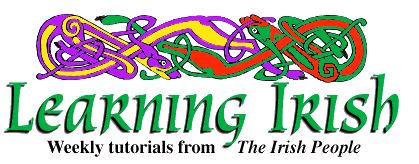
Irish Lesson 46
|
Pronunciation review The letter "i" has several sounds in Irish. If there is a síneadh fada (SHEEN-uh FAH-duh) over the "i", it will have an (ee) sound, resembling the English sound in "bee". The tongue tip, however, should be touching the lower front teeth, and the tongue center should arch up to the hard ridge behind the upper front teeth. Examples: cailín (kah-LEEN), mín (meen), bhí (vee), dílis (DEE-lish). The sound is held for a longer time than in English. If the "i" has no síneadh fada, it may still get the (ee) sound, especially if it is in an accented syllable. Examples: bia (BEE-uh), mian (MEE-uhn), Dia (DEE-uh). Usually, however, a pronounced "i" in an unaccented syllable will have a sound between (i) of English "hit" and (ee) of English "heat". Depending on the locality and the need to differentiate between similar words, such as "briste" and "bríste", the sound may be closer to (ee) or (i). It should never be exactly an English (i) as in "hit", although in words like "sin" (shin) and "cuir" (kir) it is close to that. The letter (i) may get the sound of (eye) in English "high" in some words in certain parts of Ireland. "Binn" may be (beyen). Finally, "i" may be in a word merely to show you that you must give the consonant next to it its slender sound. Examples: fuar (FOO-uhr), fuair (FOO-ir). As you go from (FOO) to the slender "r", you make a gliding sound. We represent the combination by (ir). "Áit" is another example. In going from (aw*) to the slender "t", you will make a sound that will cause the word to resemble "cynch" to some extent. Pól (pohl), Póil (POH-il) is another example.
Grammar
Sometimes we hear a person say "I be sick", indicating that he is continually ailing, as contrasted with "I am sick", indicating a present and temporary state. Irish has a form of "tá" to indicate a continuing state. It is: bím (beem), I am, I be bíonn tú (BEE-uhn too), you are bíonn sé, sí; he is, she is bímid (BEE-mid), we are bíonn sibh, siad; you (plural) are, they are The negative is: ní bhím (nee veem), I am not; ní bhíonn tú, you are not; etc. The question forms are: an mbím? (un meem), am I; nach mbím? (nahk* meem), am I not?; etc. For indirect speech: deir sé go mbím; deir sé nach mbím.
Examples: Bím tinn (beem tin), I am sick, in poor health. Tá mé tinn; I am sick now. Bíonn sé ar scoil; he is usually or often at school. Tá sé ar scoil; he is at school at this moment. Bímid ann go minic; we are often there. Táimid ann anois; we are there now.
Vocabulary
Masculine nouns geimheadh (GEV-ruh), winter lampa (LAHM-puh), lamp néal (nay*l), cloud cnaipe (kuh-NAHP-e), button
brúigh, ag brú (BROO-ee), uh BROO), press brúim (BROO-im), I press brúnn sé (broon shay*), he presses coimeád, ag coimeád (kim-AW*D, uh kim-AW*D), keep
Feminine nouns tine (TIN-e), an tine, fire (in a fireplace) grian, an ghrian (GREE-uhn, un YREE-uhn), sun
aontaigh le, ag aontú le (AY*N-tee le, eg AY*N-too le), agree with aontaím leat (AY*N-teem lat), I agree with you dún, ag dúnadh (doon, uh DOON-uh) close minic (MIN-ik), often
Reading exercise The next few lessons will have reading exercises to illustrate usage of the grammar and to review the vocabulary that you have learned. Read each exercise over first, then verify the pronunciation against the key before you look at the translation below the key.
D'eirigh Brian go moch inné, timpeall a sé a chlog. Bhrúigh sé cnaipe ar an mballa chun an lampa a lasadh, agus ansin d'fhéach sé ar a chlog. Amach as a leaba leis. Amuigh, bhí sédorcha. Ní raibh an ghrian sa spéir fós. Nigh sé é féin, agus ansin chuir sé a chuid éadaí air. Tháinig sé anuas an staighre ansin, agus fuair sé a bhricfeasta. D'éist sé leis an raido, agus é ag ithe a bhricfeasta. Clár nuachta agus ceol a bhí ann. D'éirigh an ghrian ar leath-uair tar éis a sé, agus bhí an tsráid geal ansin.
Key: DEYE-ree BREE-uhn goh mohk* in-YAY*, TIM-puhl uh shay* uh k*luhg. VROO-ee shay* kuh-NAHP-e er un MAHL-uh k*un un LAHM-puh uh LAHS-uh, AH-guhs un-SHIN DAY*-ahk* shay* er a k*luhg. un-MAHK* as un LA-buh lesh. uh-MWEE, vee shay* DUHR-uh-huh. nee rev un YREE-uhn suh spay*r fohs. ni shay* ay* fay*n, AH-guhs un-SHIN k*ir shay* uh k*wid AY*-dee er. HAW*-nig shay* uh-NOO-uhs un STEYE-re un-SHIN, AH-guhs FOO-ir shay* uh vrik-FAS-tuh. day*sht shay* lesh un RAH-dee-oh, AH-guhs ay* eg I-he uh vrik-FAS-tuh. klaw*r NOO-uhk*-tuh AH-guhs kyohl uh vee oun. DEYE-ree un YREE-uhn er la-OO-ir tuhr-AY*SH uh shay*, AH-guhs vee un traw*d gal un-SHIN.
Translation: Brian got up early yesterday, around six o'clock. He pressed a button on the wall to light the lamp, and then he looked at the clock. Out of bed with him. Outside, it was dark. The sun wasn't in the sky yet. He washed himself, shaved, and then put on his clothes. He came down the stairs then, and got his breakfast. He listened to the radio while he was eating his breakfast. There was a news program and music. The sun rose at half past six, and then the street was bright.
(c) 1998 The Irish People. May be reprinted with credit. |